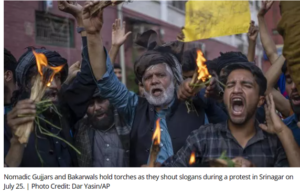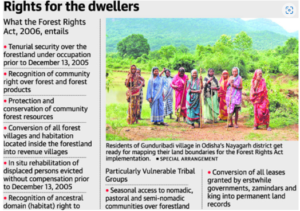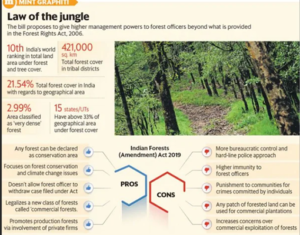In the Forest, a Transformation.
Relevance
- GS Paper 2 Issues Relating to Development SCs and STs
- Tags: #ForestRightsAct #Tribalempowerment #Indianexpresseditorialanalysis.
Why in the News?
On July 28, a group of Gujjar-Bakarwal people protested against the government’s plan to give ST status to the Pahari community, through The Constitution (Jammu and Kashmir) Scheduled Tribes Order (Amendment) Bill, 2023.
Balancing Security and Diversity
- The discussions about Jammu and Kashmir’s policies have usually ignored its diverse culture, history, and languages.
- This is because security concerns have been a priority due to a long period of insurgency.
- Tribal groups, making up about 12% of the population, Debate is how resources should be shared fairly and their rights acknowledged.
Ethnic Migratory Pastoralism in Jammu and Kashmir
In 2021, the Tribal Affairs Department conducted the First Survey of Transhumance. The survey aimed to gather evidence for making better policies. It found
- There are 612,000 people in ethnic migratory pastoral groups.
- These groups are the largest of their kind in the world, includes Gujjars, Bakerwals, Gaddi, Sippi, Dard-Shin, and Bot.
- These groups make up more than 30% of the tribal population in the Union Territory.
- Pastoral communities largely depend on livestock husbandry organised around seasonal migration between the summer pastures and winter pastures.
- This movement covers up to 600 km and happens twice a year.
- Women, children, and elderly members of the community travel along with their livestock and belongings
- Transhumant Pastoralism involves animals grazing and camping in higher pastures for a long time. Notified as demarcated forests and wildlife conservation reserves with strict rules and Management Guidelines
Community-Centric Conservation and Forest Rights Act (FRA)
- India’s Historic experience of successful community-centric conservation model and growing demand to recognize the rights of forest dwellers, especially when they clash with infrastructure projects like forest harvesting, mining, and industrialization.
- This led to the enactment of the Scheduled Tribes and Other Traditional Forest Dwellers (Recognition of Rights) Act 2006, known as the Forest Rights Act (FRA).
- Act came into force formally in 2008, implemented by all states except Jammu and Kashmir, which required special legislation
Forest Rights Act 2006: Empowering Forest Communities
Objectives
- The Forest Rights Act (FRA) of 2006 aims to recognize and uphold the rights of forest-dwelling communities, especially Scheduled Tribes and Other Traditional Forest Dwellers.
- It seeks to correct historical injustices, empower these communities, and ensure sustainable forest management.
Provisions
- Recognition of Rights: The FRA acknowledges the rights of forest dwellers over land, resources, and habitat.
- Individual Rights: It grants individual land rights to those who have lived in forests before December 2005.
- Community Rights: It provides for the recognition of community rights, allowing communities to protect and manage forests collectively.
- Cultural and Livelihood Rights: The Act safeguards cultural and livelihood rights of forest dwellers.
- Conservation and Development: The FRA balances conservation with development by allowing the use of forest land for essential services like healthcare, education, and infrastructure.
- Change from the Past: Earlier, forest laws didn’t allow these services except when land was used for big projects and the affected people were compensated.
Success Story
Gudiya tribal community in the Aravali Hills of Rajasthan.
- The Gudiyas had been living in the forests for generations, but they were evicted from their land in the 1970s to make way for a wildlife sanctuary.
- The FRA helped the Gudiyas to regain their land and to secure their forest rights.
- The Gudiyas are now able to live in their traditional way and to manage their forest resources sustainably.
Path to FRA Implementation in Jammu and Kashmir: Post-2019 Progress
Jammu and Kashmir Reorganisation Act, 2019 opened the Door for FRA Implementation
- On August 5, 2019, the Government of India revoked Article 370 of the Indian Constitution, which granted special status to Jammu and Kashmir.
- This meant that all central laws were made applicable to Jammu and Kashmir, with some exceptions.
Delayed Start with Renewed Efforts
The FRA implementation, postponed for 15 years, finally began in 2021.The process was initiated through several key steps:
- Public communication to raise awareness
- Capacity building to prepare stakeholders
- Development of rules and guidelines
In September 2021, a significant milestone was reached with the formal FRA implementation.
- Srinagar and Jammu witnessed historic ceremonies organized by the Tribal Affairs Department and the Forest Department.
- Tribal forest dwellers were handed titles by the Lieutenant Governor, marking a step toward empowerment.
2011 decadal census and FRA implementation
- India’s 2011 census reported around 5 million tribal people, making up 8.6% of the whole population.
- Jammu and Kashmir (J&K), with a tribal population of 12%, started implementing the Forest Rights Act (FRA).
Comparative Implementation
- While J&K introduced FRA, 20 other states with significant tribal communities had already resolved 47% of individual rights claims and 59% of community rights claims over forest land.
- People who had been silent about J&K’s rights deprivation for a long time are now questioning the apparent delay in granting rights after FRA’s rollout.
- Challenge is more than just numbers, it’s about enabling communities to understand and assert their rights.
FRA Implementation Progress in J&K: September 2021 – May 2023
| Titles Issued and Family Benefits | |
| Number of Titles Granted | >4,500 |
| Families Benefited | 60,000 |
| Impact | Access to forest land and related resources |
| Community Forest Resources Titles | |
| Community Titles Granted | 44.59% of total claimants (9,423) |
| Significance | Recognition of community rights over forest resources |
This recognizes community rights over forest resources, indicating progress in recognizing collective benefits.
Challenges with Individual Forest Rights
- The focus on individual forest rights remains a challenge.
- This requires supporting tribal families in applying for these rights and providing necessary records.
Challenges Of Forest Rights Act Implementation
Considering Tradition and Records
- FRA implementation is distinct from typical government welfare schemes.
- It must respect traditional folklore and record-keeping methods.
How to Navigate Challenges?
Overcoming tough terrains and geographical barriers
- Many forest-dwelling communities reside in remote areas that may lack proper infrastructure and transportation, making it challenging for government officials and resources to reach them effectively
Managing mobile communities’ needs and movements
- Certain tribal communities have a mobile lifestyle, moving between different areas for livelihood and resources.
- Adapting FRA implementation to cater to these mobile communities requires flexibility and coordination to ensure their rights are recognized even as they move.
Addressing poor literacy rates
- Low literacy rates among forest-dwelling communities can hinder their ability to understand and navigate the legal processes and paperwork required for FRA implementation.
- This presents a barrier that needs to be addressed through accessible information and support.
Intangible Aspects
Dealing with feelings of historical deprivation and exclusion
- Historical injustices and neglect suffered by forest-dwelling communities can lead to feelings of deprivation and exclusion.
- These emotional and psychological aspects must be considered during FRA implementation to foster trust and cooperation within the communities.
Community-led process is crucial
- A community-led approach ensures that the implementation aligns with their needs, practices, and cultural sensitivities.
Leadership and Gap Mitigation
- Absence of leadership could widen disparities within the community, ensuring access to provisions for all, regardless of their background.
Disposal Rates and Empowerment
- Disposal rate of community FRAs is 45%, while individual rights are much lower. Families struggle to prove eligibility on their own.
Collective Efforts for Change
- Tribal Affairs Department, NGOs, and youth groups are actively engaging, started an outreach to address this and are working on models to enable individual families to claim their rights under the FRA.
Gram Sabha’s Role
- Gram Sabha consists of officials, non-officials, and elected members of tribal communities.
- Over 92.57% of rejected FRA claims were declined by the Gram Sabha.
- Only 7.43% claims were rejected at Sub-Divisional and District Committee levels.
- Signifies the need for capacity-building in local self-government and community members.
Core Responsibility and Community Empowerment
- Government departments and community leadership hold core responsibility. Building capacities crucial for effective FRA implementation.
- FRA’s success needs community-driven approach.
Progressive Policy Change in December 2022
- In December 2022, a new policy eliminated commercial tendering of forest produce.
- Empowered tribal pastoralists and forest dwellers to collect, process, and commercialize non-timber forest produce.
- A significant step towards recognizing pastoral tribes’ rights over resources, promoting sustainable use and conservation.
Access to Services and Literacy Challenges
- FRA not only grants access to forest resources but also enables services like healthcare, education, energy, and connectivity.
- Poor literacy rates pose challenges:
- Tribal population: less than 50% literacy
- Migratory tribes: 16.74% literacy
- Coupled with the absence of required records, seasonal migration and local socio-cultural issues pose a serious challenge to FRA implementation.
Collective Efforts for FRA Success
It requires all stakeholders, governmental and non-governmental in recognizing and addressing the needs and rights of tribal communities, ensuring inclusive growth and development of Jammu and Kashmir
Mains Question
Discuss the issues pertaining to the implementation of Forest Rights Act (FRA) 2006. Highlight its significance for the tribal community in India.






